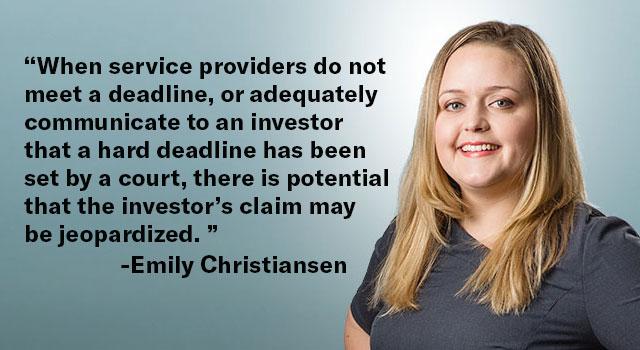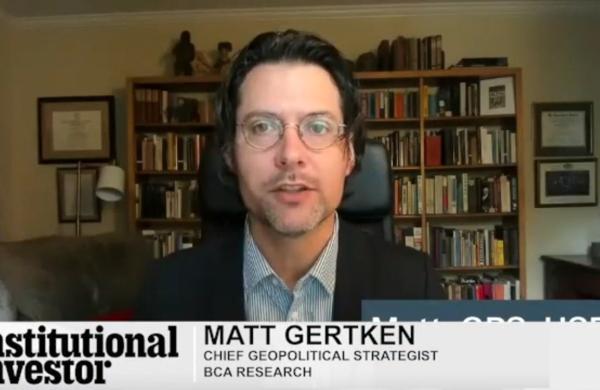Many third-party claims filing service providers offer services to clients for shareholder litigation outside the U.S. where an investor is required to opt-in to participate at the inception of the litigation. These services are not quite what they purport to be, and investors should be careful not to assume they are fully covered when they rely on a third-party claims filing service provider to evaluate and join actions outside the U.S.
The best way to protect yourself is to know the right questions to ask – of yourself – and what to keep an eye on. II recently asked Emily Christiansen, a partner at Kessler Topaz Meltzer & Check (KTMC) for her suggestions on points institutional investors should raise with any third-party claims filing service. The answers will help investors determine if their interests are protected or if there are deficiencies in the services they are receiving.
“The questions and discussion points we recommend are based on real-world examples of the risks posed to institutional investors who solely rely on third-party claims filing services to navigate the global landscape and register them for non-U.S. opt-in litigation,” says Christiansen. “We witnessed many of these examples in preparing and filing some of our active cases; a few are examples we identified while assisting and advising investors how best to correct a problem created by a third-party claims filing service.”
Here’s Christiansen’s list of essential questions, along with her related insights.
Are you receiving adequate notice regarding potential actions to join? How does the service provider ensure they are collecting and providing you with all relevant information in a timely manner? In a recent case, a third-party service provider contacted KTMC for the first time two days before the registration deadline we advertised and asked for additional information. The service provider asked if we would calculate and provide estimated damages for hundreds of its clients. At that point, we had been advertising the case and registering investors to participate in the case for more than four months. We informed the service provider that it was too late. Its response was that it had emailed an attorney three months earlier and had not heard back. They made no attempts to follow up or to conduct further due diligence. Their clients were not registered for this actions and there were no other groups to join, they simply lost the opportunity to recover.

If you plan to join or have already joined an action, how quickly will the service provider reach out to you for any documentation or information requested by the local law firm or litigation funder? Are they providing adequate notice in advance of a deadline? Or are they sitting on things for days or weeks after they receive a request? Unfortunately, it is not unusual for third-party service providers to struggle meeting deadlines. Many service providers do not have lawyers on staff, and their representatives appear to operate as though they are submitting a claims form (where there is often some flexibility and where a placeholder can be filed). What they fail to understand is that there are real consequences involved in missing deadlines or providing incomplete information in active litigation. When service providers do not meet a deadline, or adequately communicate to an investor that a hard deadline has been set by a court, there is potential that the investor’s claim may be jeopardized.
What have you actually authorized your service provider to do with respect to non-U.S. litigation? Some service providers attempt to sign retainers and power of attorney agreements on their clients’ behalf. While they may have a power of attorney executed by a client that allows them to sign and submit claim forms in U.S. class action settlements, that same authority is not sufficient for registering for and joining non-U.S. litigation because the agreement with the service provider is usually limited in scope. Most courts outside the U.S. will only recognize documents that are signed by official authorized signatories of the investor. Even setting aside the formal requirements that preclude a service provider from registering for an action on an investor’s behalf in many jurisdictions, many investors are unaware that their service provider attempted to register them for active litigation. Indeed, in many instances, when we go back to the service provider to obtain the necessary documentation, there are investors that elect to then withdraw from the case. This can be especially dangerous in loser pays jurisdiction or with agreements that provide for a financial penalty for withdrawing.
Get to Know SecuritiesTracker
Asset managers face endless responsibilities and opportunities related to shareholder litigation, and what might be the best way for time-starved legal and operations professionals to stay on top of it all is a single-source platform. SecuritiesTracker is just such a secure and comprehensive platform. It combines portfolio monitoring and claims filing with case evaluations that include legal analyses and recommendations to guide fund managers to quickly determine how best to monetize claims and avoid leaving money on the table. The goal of SecuritiesTracker is to obtain the best possible return from their funds’/clients’ claims arising from securities class actions, opt-outs, anti-trust actions, or the growing number of non-U.S. shareholder actions.
How informed is the service provider regarding the case, and what documentation and information will be required of you? Do they properly inform you of that information before registering you to participate or encouraging you to join an action? We have heard from investors seeking assistance when they joined an action in a country where more evidence and work is required in connection with their participation in the action (for example, some actions in the U.K. require evidence of reliance). The investors become frustrated because their service provider is not able to sufficiently explain or prepare them for what is or may be required in the action. As a result, often times the case proves to be more work than they bargained for.
How organized is the provider? Are they keeping adequate records of who they are in contact with at your firm? Are they keeping adequate records of what they’ve requested and sent to the law firm organizing the action on your behalf? A lack of organization seems pervasive at many third-party service providers. KTMC has seen service providers fail to keep track of their list of clients they registered for an action and of documentation or information they provided. Service providers are not accustomed to managing active litigation, and frequently they lose track of what information has been requested from them on behalf of their clients, and repeated reminders are required in order to finally get complete documentation. In one instance, we had a service provider ask us whom at their investor/client to reach out to in order to request certain documentation because it did not track its prior communication. We also notice that many of these providers do not have a central contact person and, as a result, they utilize various representatives to manage the process of requesting and producing necessary documentation.
Does the service provider have data analysts review your transaction data before submission in order to ensure everything balances, that all your accounts with trades are included, and to ensure there are no other issues or inconsistencies? If the law firm pursuing the case has questions about the data, are they well-equipped to review and answer those questions or to communicate the questions to your data teams? Third-party service providers frequently send us transaction data on behalf of clients that is out of balance and clearly missing accounts or transactions. It is apparent that the data was never reviewed prior to transmission, and that creates a lot of back and forth. This presents a risk if the law firm running the litigation also does not have data analysts reviewing the data before submitting it to the relevant court. This incomplete process may jeopardize your claims or the amount of damages you are eligible to recover. It also calls into question whether any analysis is being done prior to the service provider filing a claim for U.S. class action settlement proceeds and whether you are receiving the full compensation to which you are potentially entitled.
These real examples are intended to raise questions with investors with global portfolios. The issues presented are generally applicable when third-party claims filing services use client service representatives that have no legal background and do not understand many of the nuances associated with non-U.S. litigation (for example, recognizing the differences between submitting a claim form in a U.S. class action settlement and registering for an active litigation). When third-party claims filing providers do employ persons with a legal background, it is important to question whether and to what extent they have experience with litigation. Further, these providers should be able to demonstrate their experience and expertise with managing actions outside the U.S. Investors are encouraged to vet their providers along these lines so they can better understand the true level of services being offered. This sort of analysis will go a long way to ensure that investors’ interests are indeed protected.





